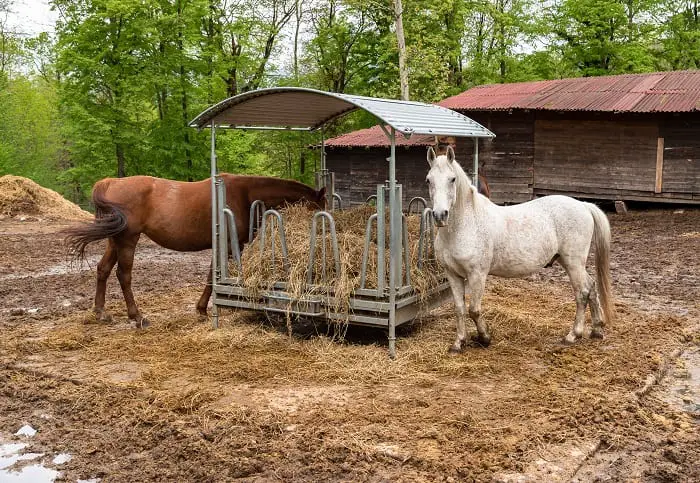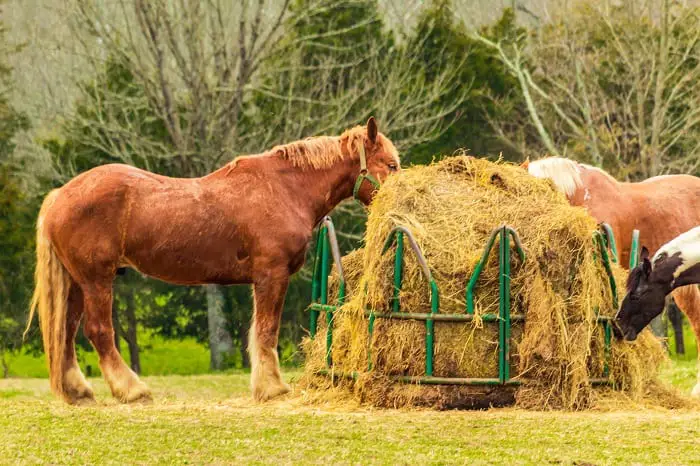Last Updated on December 17, 2021
Hay is for horses! If you haven’t heard this phrase, you haven’t been around horses for very long! Horses around the world are known for eating hay as one of their primary, staple foods. But how much hay does a horse eat?
Horses eat many things, such as grain, oats, grass, and various treats (carrots, apples, horse cookies, peppermints, etc.), but they are best known for eating hay. But, feeding hay may not be as simple as it seems.
In this article, I will be discussing how much hay a horse should eat daily. While there is no simple answer to this question, I’ll be discussing how a horse’s lifestyle, a horse’s size, and a horse’s age can affect the amount of hay your horse should be eating daily!
How Much Hay Does a Horse Eat, Lifestyle
So, how much hay should a horse eat daily? Well, as always, it depends. One of the factors that it depends on most is a horse’s lifestyle. Every horse has a different schedule and a different routine.
For example, some horses life outside 24-7, while other horses are only allowed an hour or two of turnout a day. Some horses get turned out on grass pastures, and some horses live in climates where grass turnout is not a realistic option.
While hay is what horses are known for eating, hay is not the only type of “forage” a horse can eat. “Forage” or “roughage” is the primary element of a horse’s diet. But, there are more forms of forage than just hay.
The grass is also a viable form of forage for horses. So, horses that have constant access to grass may not need as much hay. Likewise, horses that don’t have access to grass may require more hay. A healthy mix of both is preferred, but not always available in most climates and regions.
The exact amount of hay a horse needs will depend on other factors, but it’s important to consider how much access to grass your horse has when determining the healthy amount of hay to feed.
How Much Hay Does a Horse Eat, Size of Horse
The amount of food a horse gets wholly depends on the horse’s size. This applies to the amounts of hay, grain, oats, or any other feed a horse has access to. The amount of food varies from circumstance to circumstance; some horses need to lose weight, others need to gain weight, and still, others are striving to maintain the same weight.
Thankfully, there are many resources that can help you determine how much your horse should eat based on its size. First and foremost, consult your vet, your barn manager, your trainer, or any other experienced resource at your disposal and get their opinions.
If you’re still questioning what amount is right, there are online resources that can help. For example, Purina has a “Horse Feeding Calculator” that measures your horse’s lifestyle and weight and spits out the ideal amount of food a horse should be getting.
Access the Purina Horse Feeding Calculator at the following link: https://www.purinamills.com/horse-feed/tools/horse-feed-calculator
The Kentucky Equine Research Institute has also created a useful table that measures how much forage a horse should be getting, in percentages, based on the horse’s size and age. For example, it lists performance horses separate from weanlings, separate from pregnant mares.
Ponies will need different amounts of hay than draft horses, draft horses will need different amounts of hay than pregnant mares, pregnant mares will need different amounts of hay from sporthorses, and so on and so forth.
Access to hay is also an important tool in helping your horse lose or gain weight. Though your horse doesn’t ever change in height or “type” per say, his “size” is affected through the loss or gain of weight.
Say your horse gets 4 flakes of hay on average, but typically drops weight in the winters. It may be a good choice to increase your horse’s flake count during the winter months to help him maintain a healthy weight. Though your horse doesn’t change in height or “type” per say, his “size” is affected through the loss or gain of weight.
Averages
To give some average numbers, most horses at my barn have 8-hour turnout with access to grass and hay outside daily, are classified as performance horses, and get about three flakes of hay inside twice a day.
So, six flakes total inside, along with 8-hour free access to grass and hay. They also eat two meals of grain with supplements, and whatever treats their owners bring. These are horses on almost daily workout programs.
In my experience, this is normal for performance horses. Horses that are retired from work, or only work once or twice a week may need less hay. Just like people, when horses burn less calories, they need to consume less calories.
Dr. Bob Coleman, Ph.D. and assistant professor and extension horse specialist at the University of Kentucky concludes that horses should be eating 1.5-2.5% of their body weight in forage daily.
So, for a 1,000-pound horse, this could be anywhere from 15-25 pounds of grass and hay per day. Again, the split of the two forages will depend on how much grass pasture access your horse has, but this can be a helpful basis for determining how much hay your horse should be getting.
Conclusion
The amount of hay a horse needs to eat daily is completely subjective! This means that there is no all-inclusive answer to this question. The amount of hay a horse should eat daily entirely depends on each horse’s size, condition, lifestyle, and more.
Always consult your vet, manager, or trainer when making these decisions. And, also utilize tools such as the Purina Horse Feed Calculator and the Kentucky Equine Research institute’s forage table.
I hope this article has helped you better understand how to determine the correct and healthy amount of hay for horses to eat daily. If so, please share this article, and share with us your experiences determining feeding schedules!
FAQs
How long will a bale of hay last a horse?
The amount of hay eaten depends on the type of horse, the size of the bale, the workload, the horse's activity level, access to pasture, and the quality of the hay. However, most horses eat between 10-15 pounds of hay each day. Therefore, a standard 40 lb. square bale of hay will lasts one horse for about 3.5 days.
Can you overfeed hay to a horse?
It's not hard to overfeed hay to a horse. If the horse eats too much hay, it will have trouble digesting it properly and may become ill. Horses are very sensitive to the amount of food they eat, so you must be careful not to overfeed them. Overfeeding can lead to diseases of the horse's body such as equine metabolic syndrome and laminitis.
Equine metabolic syndrome (EMS) is a collection of signs and symptoms that affect the equine athlete. It is an umbrella term used to describe a variety of disorders that may result in weight gain, hyperglycemia, insulin resistance, hyperinsulinemia, laminitis, and other conditions. EMS has been described in horses as well as other species including dogs, cats, donkeys, and humans.
How much hay should a 1000 lb horse eat?
If only being fed hay, a thousand-pound horse eats on average fifteen to twenty pounds of hay a day. But what is the Optimum Amount of Hay? According to the National Association of State Universities and Land Grant Colleges, “the amount of hay required to maintain the nutritional needs of adult horses varies considerably, depending on their breed and type, age, body condition, level of activity, environmental conditions, and the availability of feed. Therefore, the actual amount of hay will be different from horse to horse and you'll have to figure it out with observing your horse's performance, health status, and his habits.
Should horses have hay all time?
To help keep horse's digestive system working correctly, it's advisable to have a constant access to hay. That doesn't mean that a horse has to eat all the time, of course, but that he is free to munch on either hay or graze on pasture whenever he feels like it. In that way a horse will only eat small amounts of food at a time and allow his digestive system to function optimally without overloading it.
How much hay will an acre grow?
There are no hard and fast rules about how much hay you can produce on one acre, but the more nutrients your soil has, the more hay you should be able to produce. The most important thing to remember is that the quality of your forage is limited by the quantity of nutrients available in your soil.
An average yield of hay per acre is somewhere between 1 and 2 tons per cutting. Some grasses can yield much more, but this is usually the result of an exceptionally good growing season. The most important factor in a high yield is a good growth cycle. The growing season should be long enough so that all the plants have time to mature. A long growth cycle is best achieved by early planting and late harvesting.
Michael Dehaan is a passionate horse owner, horse rider, and lover of all things equine. He has been around horses since he was a child, and has grown to become an expert in the field. He has owned and ridden a variety of horses of different breeds, and has trained many to compete in shows and competitions. He is an experienced horseman, having worked with and competed many horses, including his own. He is an active member of the equestrian community, participating in events and teaching riding lessons.


